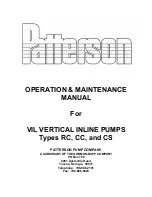
835959-UIM-D-0814
6
Johnson Controls Unitary Products
SECTION V: EVACUATION
During this process, it is necessary to evacuate the system to 500
microns or less. If a leak is suspected, a dry nitrogen charge is used to
locate leak(s). After repairing any leaks, another leak test is to be per-
formed.
To verify that the system has no leaks, the system is held under a vac-
uum by closing the valve to the vacuum pump suction isolating the
pump. The micron gauge is observed for a few minutes. If the micron
gauge indicates a steady and continuous rise, it is an indication of a
leak. If the gauge shows a rise, then levels off after a few minutes and
remains fairly constant above 500 microns, it is an indication that the
system is leak free but still contains moisture and may require further
evacuation. Proper system evacuation requires the micron gauge to
indicate a vacuum holding below 500 microns for several minutes.
SECTION VI: SYSTEM CHARGE
To ensure that your unit performs at the published levels, it is important
that the indoor airflow is determined and refrigerant charge added
accordingly.
MEASURE INDOOR AIR FLOW
To determine rated air flow for a specific match, consult the technical lit-
erature at www.upgnet.com. When attempting to match this air flow,
select the lowest possible speed tap, measure the actual flow, and
adjust as necessary.
To measure actual air flow, it is not an acceptable method to just
check the jumper pin setting tables and to assume 0.5” static pres-
sure drop.
To determine indoor air flow, first measure the static pressure with a
manometer between the filter and blower. On a single-piece air handler,
take a second reading after the coil. On a furnace or modular air han-
dler, take the second reading after the heat exchanger, but before the
indoor coil. Add the negative return static to the positive supply static to
determine the system total static pressure. Treat the negative return
static as a positive pressure (even though it is a negative reading). If
there is static pressure on the blower (i.e. -.10) return, add it to a supply
static (.40) which equals a (.50) total system static pressure. Compare
this value to the table for the indoor unit's static pressure vs. CFM or to
a curve chart.
CHARGING THE UNIT
The factory charge in the outdoor unit includes enough charge for the
unit, 15 ft. (4.6 m) of refrigerant piping, and the smallest indoor coil/air
handler match-up. Some indoor coil/air handler matches may require
additional charge.
See Tabular Data Sheet provided in unit Customer Booklet for charge
requirements.
The “TOTAL SYSTEM CHARGE” must be permanently marked on the
unit data plate.
TOTAL SYSTEM CHARGE DETERMINED
1. Determine outdoor unit factory charge from Tabular Data Sheet.
2. Determine indoor coil adjustment (if any) from Tabular Data Sheet.
3. Calculate the additional charge for refrigerant piping using the Tabu-
lar Data Sheet if line length is greater than 15 feet (4.6 m).
4. Total system charge = item 1 + item 2 + item 3.
5. Permanently mark the unit data plate with the total amount of refrig-
erant in the system.
CHARGING IN COOLING MODE
The unit includes heating charging charts and cooling charging charts.
All units include a subcooling charging chart for cooling. If a charging
chart is not on the unit, then it can be obtained at www.upgnet.com
under the Heating Service Condenser Guide.
Cooling charts should not be used to charge the unit. They are ref-
erence charts for servicing the unit.
After the unit has been serviced, collect the charge and weigh it
back in according to the directions.
When charging a unit in cooling mode, the charge MUST be weighed in.
Charging by any other method, such as superheat, subcooling, cooling
charging charts, feeling the line set, etc is not acceptable. Most heat
pumps are sensitive to charge in heating, requiring more charge, so
charging by an unacceptable method will cause the unit to perform
poorly in heating mode.
Refrigerant charging should only be carried out by a qualified air con-
ditioning contractor.
R-410A refrigerant cylinders are rose colored, and have a dip tube
which allows liquid to flow out of the cylinder in the Upright Posi-
tion. Always charge the system slowly with the tank in the upright
position.
Compressor damage will occur if system is improperly charged. On
new system installations, charge system per tabular data sheet for
the matched coil and follow guidelines in this instruction.
Do not leave the system open to the atmosphere. Unit damage
could occur due to moisture being absorbed by the POE oil in the
system. This type of oil is highly susceptible to moisture absorp-
tion.
DO NOT attempt to pump “Total System Charge” into outdoor unit for
maintenance, service, etc. This may cause damage to the compres-
sor and/or other components. The outdoor unit only has enough vol-
ume for the factory charge, not the “Total System Charge”.
IT IS UNLAWFUL TO KNOWINGLY VENT, RELEASE OR DIS-
CHARGE REFRIGERANT INTO THE OPEN AIR DURING REPAIR,
SERVICE, MAINTENANCE OR THE FINAL DISPOSAL OF THIS
UNIT.
This method is for systems that only have interconnecting lines. If
any other objects that adjust the charge levels are placed between
the indoor and outdoor units (example: a refrigerant flow meter), then
before adding charge, the device must first be removed. Follow the
steps above. Run the system in both cooling and heating mode and
record the high side pressure in each mode. Then insert the device
and charge the system by matching the same high side pressure in
both heating and cooling as that value recorded without the device. It
is not acceptable to add a pre-determined charge amount listed by
the device manufacturer nor is it acceptable to use any other method.
NOTICE

































